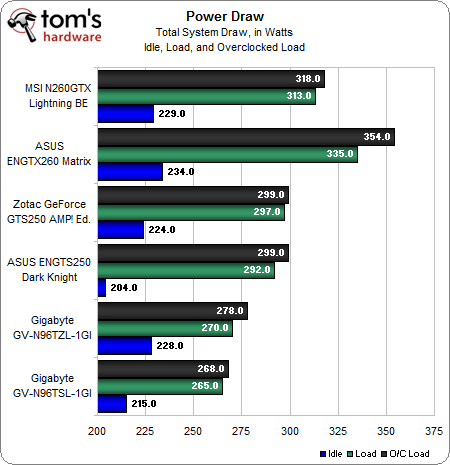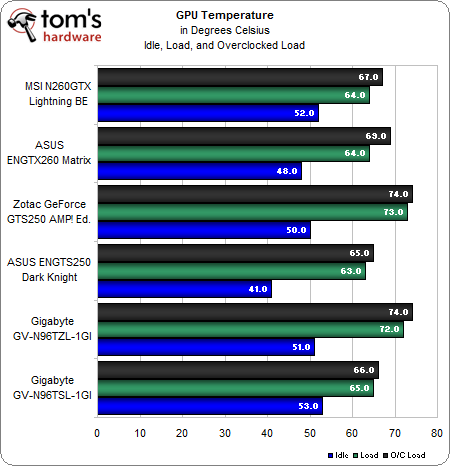GeForce 9600 GT/GTS 250/GTX 260 Non-Reference Roundup
Power, Temperature, And Noise Benchmarks
Now that we know the relative performance of these cards, let’s look at their other statistics:
We'll start with power draw. Note that we begin the graph here at 200 W, which is close to what this system draws with a power-sipping GeForce 8400 GS running at idle. These results paint an interesting picture.
Starting with Gigabyte's low-end GeForce 9600 GT solutions, we see a uniform result from these cards with the lower-clocked passive version using a little less power. This makes sense as the passive GV-N96TSL-1GI has a slightly lower clock speed than the actively cooled GV-N96TZL-1GI.
The GeForce GTS 250 solutions show us a marked difference in idle power use. In fact, the Asus EBGTS250 Dark Knight uses less power at idle than even the GeForce 9600 GT cards do. This is because the Dark Knight has a very aggressive power-saving mode and only runs the card at 300 MHz core/100 MHz memory in 2D mode, according to the GPU-z utility. Once loaded in a 3D game or overclocked, both of these GeForce GTS 250 cards demonstrate virtually identical power draws.
The Asus and MSI GeForce GTX 260 cards show similar idle power draw, but the Asus Matrix shows a much higher load power draw. This is likely due to a number of factors: the MSI’s 10-phase power management is likely more efficient than the Matrix’s and the Matrix card allowed us to over-volt to a higher level than with the Lightning mode. We should note that it would have been possible to under-clock and under-volt the 2D profile of the Matrix card to achieve low-power results similar to the Dark Knight's power draw at idle, while the MSI Lightning has no provisions for under-clocking and under-volting as far as we could tell.
The GPU temperature graph doesn’t show us much except that all of these cards run their GPUs in a similar temperature range. All of the coolers here are doing good jobs, with loaded overclocked temperatures remaining under 80 degrees Celsius. The Asus ENGTS250 Dark Knight and Gigabyte GV-N96TSL-1GI get props for keeping loaded temperatures notably less than 70 degrees Celsius. Especially impressive is the Gigabyte GV-N96TSL-1GI, since it is a passively-cooled card.
We started the noise graph at 45 decibels. This is because the Gigabyte passively-cooled GV-N96TSL-1GI produces no noise at all with its passive cooler and we measured 47.5 decibels of noise caused by the system itself.
Get Tom's Hardware's best news and in-depth reviews, straight to your inbox.
While the temperatures are uniform, the amount of noise produced is not. The Zotac is hard to miss with its loud reference cooler at 56 decibels. Every other card managed to keep things reasonably quiet below 53 decibels.
Current page: Power, Temperature, And Noise Benchmarks
Prev Page Overclocking Benchmarks Next Page ConclusionDon Woligroski was a former senior hardware editor for Tom's Hardware. He has covered a wide range of PC hardware topics, including CPUs, GPUs, system building, and emerging technologies.
-
Mottamort I was rather disappointed with this article. Not the article itself but with the slightly misleading Title/Intro. When clicking the article I thought I was going to find a massive battle between these vendors on different tiers, instead you show us different instances of 2 slightly different cards of the same type from one vendor....if that makes senseReply
I mean you have Gigabyte vs Gigabyte in the 9600gt section, Asus vs Asus in the 250 section and so on.
:-/ -
dragonsprayer Great articleReply
i wish it had more cards, i think you need 4 parts, try some back cards like the 4870x2 darkknight? good stuff as always!
thx! -
crisisavatar wow how is the gts 250 performing so close to the gtx 260 wasn't the gtx 260 20% faster ?Reply -
enterco It's not clear to me why are you comparing '3dmark score' when you should post 'GPU score'.... It's a graphics card comparision, not platform comparision.Reply -
randomizer entercoIt's not clear to me why are you comparing '3dmark score' when you should post 'GPU score'.... It's a graphics card comparision, not platform comparision.Nothing but the cards is changed so you're not comparing platforms.Reply -
acasel We cannot see clearly the bang for the buck card there if we ain't seeing some ati cards like the 4770 and others..Reply
The drop down menu sure is fast... :-) -
enterco randomizerNothing but the cards is changed so you're not comparing platforms.Sure. A reason more to show GPU score. 3dmark score is too much influenced by CPU's power, and it's no longer relevant, the way it used to be once...Reply
By using a Quad Core and a low-performing GPU you can achive same 3dmark score as using a dual core combined with a considerably stronger GPU, 3dmark Vantage gives too much credit to CPU. But the overall FPS in games it's often higher in the second case: dual core + better GPU. -
marraco Recent review showed the 260 being neck to neck with the 4870; both in price and performance, those cards are in the same point.Reply
Since my 8800GT should be between the 9600 and the 250, I guess that the best upgrade path is to buy a second 8800GT, reaching probably 260/4870 performance.
I searched the web for 8800GT SLI benckmark running in i7 920, but got no one single review...
I think that tomshardware should review non up-to-date cards as the 8800 and the ATI equivalents, in crossfilre/SLI, since for many users, it should make sense to buy a second card that to upgrade to a 260/4870.
older reviews on those cards does not accounted for the scalability on I7 x58 platform, and probably ATI and Nvidia dedicated more time tweaking drivers for newer cards, so maybe the 8800GT does not perform well today (the SLI on core 2/Quad did not worked very well in the past)


